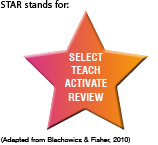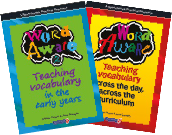At a recent Language Link Training session, a year 1 teacher commented, “I know part of my role is to develop vocabulary but how do I choose the right words to work on?” Here we ask ‘Word Aware’ authors Anna Branagan and Stephen Parsons to explain how to use the STAR process to teach new vocabulary effectively.
Communication and language are the best predictors of later attainment, not only in literacy but also in maths (Better Communication Research Programme, 2011). This makes sense: a good talker is an effective learner.
Vocabulary is particularly powerful because of its links with literacy and other curriculum areas. Research shows that orally tested vocabulary at the end of first school year is a significant predictor of reading comprehension 10 years later (Cunningham and Stanovich, 1997).
The good news is that there are lots of quick and easy ways to promote vocabulary learning. In this article, we outline the STAR process – a particularly effective way to teach vocabulary.
STAR stands for:

SELECT
TEACH
ACTIVATE
REVIEW
(Adapted from Blachowicz & Fisher, 2010)
It can be used across any year group and is a good approach for all students including those with SLCN and EAL.
Selecting Vocabulary
Selecting the right level of words to teach is an important first step. Words should be new to most of the children, but common enough to be encountered again. Start by making a list of words that are important to the topic or lesson then divide them into the following broad categories. We are using minibeasts as an example topic.
ANCHOR WORDS
- Children have a thorough understanding of these words.
- Everyday spoken language for a child of this age.
- Used at home and in daily interactions.
- spider, wiggle, look, careful, caterpillar
GOLDILOCKS WORDS
- Really useful words likely to be encountered again.
- Average older child has a good level of knowledge of the word.
- Words that are very topic specific but core to the topic.
- dragonfly, centipede, squirm, search, delicate
STEP ON WORDS
- Less likely to be encountered again.
- Average older child does not have much knowledge of the word.
- Words that are particularly topic-specific and not core to the topic.
- tarantula, scuttle, monstrous
Teaching Vocabulary
Work on each Goldilocks word using a range of multi-sensory strategies.
SYMBOL
- Draw or find a symbol or picture that represents the target word.
SPEECH SOUNDS
- Clap out the syllables of the word.
- Say the word to a partner.
MEANING
Add meaning in a variety of ways:
- Use sensory experiences that make an impact to convey the meaning. For example, when teaching squirm, get the children to wriggle/squirm on the spot!
- Use simple vocabulary to define the new word.
- Link the word to other words with similar meanings.
- Tell a story which highlights the meaning of a word. For example, when teaching squirm make up a story about a mouse escaping from a cat by squirming.
ACTION
Where possible use an action, sign or gesture to represent the word.
WORD AWARE SONGS
Use songs to reinforce the new words. Google ‘You Tube Word Aware songs’.
WORD WALL
- Put up the picture or symbol on the wall to remind adults to use it, so that the children hear it again.
- Use string to link different words together on the word wall, e.g. squirm and wiggle, delicate and careful
Activate New Words
Children need to hear new words lots of times to strengthen the links needed to store and recall them. Words grow as children encounter them throughout the day.
- Adults need to use words in interactions with children. Have the words up around the room to remind practitioners.
- Adults use comments not questions. Use the word to describe a child’s actions rather than quizzing them about the meaning of a word e.g. I can see your handling that very delicately.
- Involve children in small group work: encourage children to sort objects into delicate things and things that are not delicate.
- Provide play-based opportunities: act out new verbs, go on treasure hunts looking for things that squirm or are delicate.
Review
The final stage in the STAR process is ‘review.’ Reviewing words prevents them being forgotten.
- Find objects that represent each word and place them in a ‘word bag’. Use this as a prompt to talk about at carpet time.
- Encourage parents to use the new words at home.
There are lots more ideas in our book: Word Aware 2: teaching vocabulary in the Early Years and also at www.pinterest.com/wordaware/
Find out more from Anna Branagan & Stephen Parsons at www.thinkingtalking.co.uk

References
- Blachowicz C & Fisher P (2010) Teaching Vocabulary in All Classrooms, 4th ed, Allyn and Bacon, Boston, MA. Cunningham A & Stanovich K (1997) ‘Early reading acquisition and its relation to reading experience and ability 10 years later’, Developmental Psychology, 33, 934–45.
- Parsons S & Branagan A (2016) Word Aware 2, Speechmark, London. Stahl S & Nagy W (2005) Teaching Word Meanings, Lawrence Erlbaum Associates, Mahwah, NJ.
- https://www.gov.uk/government/publications/better-communication-research-project-language-and-literacy-attainment-of-pupils-during-early-years-and-through-key-stage-2
Read our interview with Anna at The Link Online.
Please login to view this content
Login